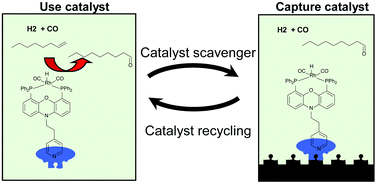Abstract
This article describes a new strategy for the recycling of a homogeneous hydroformylation

- This article is part of the themed collection: In Celebration of David Cole-Hamilton's Career in Chemistry
* Corresponding authors
a
InCatT B.V. Science Park 904, 1098 XH Amsterdam, The Netherlands
E-mail:
joost.reek@incatt.nl, sander.kluwer@incatt.nl
Fax: +31 20 5256422
Tel: +31 20 5256437
b Catfix B.V. Science Park 904, 1098 XH Amsterdam, The Netherlands
c
Van't Hoff Institute for Molecular Sciences, University of Amsterdam, Science Park 904, 1098 XH Amsterdam, The Netherlands
E-mail:
j.n.h.reek@uva.nl, A.M.Kluwer@uva.nl
Fax: +31 20 5256422
Tel: +31 20 5256437
This article describes a new strategy for the recycling of a homogeneous hydroformylation

 Please wait while we load your content...
Something went wrong. Try again?
Please wait while we load your content...
Something went wrong. Try again?
A. M. Kluwer, C. Simons, Q. Knijnenburg, J. I. van der Vlugt, B. de Bruin and J. N. H. Reek, Dalton Trans., 2013, 42, 3609 DOI: 10.1039/C2DT32047A
To request permission to reproduce material from this article, please go to the Copyright Clearance Center request page.
If you are an author contributing to an RSC publication, you do not need to request permission provided correct acknowledgement is given.
If you are the author of this article, you do not need to request permission to reproduce figures and diagrams provided correct acknowledgement is given. If you want to reproduce the whole article in a third-party publication (excluding your thesis/dissertation for which permission is not required) please go to the Copyright Clearance Center request page.
Read more about how to correctly acknowledge RSC content.
 Fetching data from CrossRef.
Fetching data from CrossRef.
This may take some time to load.
Loading related content
